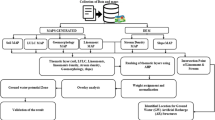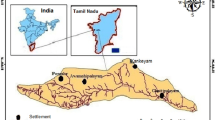Abstract
The identification of ground water potential zones in the Chinhat block, district Lucknow, U.P. has been carried out based on the scientific investigation of drainage, gydro-geomorphology, lithology, soil, land use and land cover, geo-resistivity data and their inter-relationship. Thematic layers of drainage, canal, surface water body, geomorphology, lithology, lineament, soil, and land use and land cover were prepared with the help of satellite images. Field traverses along litho-stratigraphic units was made to check ground truth. Dug well data were collected at different locations in the district. digital elevation model (DEM) of the area was generated using SRTM data. Slope map was prepared from DEM. To generate these layers a step-approach, i.e., digitization, editing, building topological structure and finally, polygonization for GIS overlay analysis was followed.
Every class in the thematic layers were placed into one of the following categories viz. (i) excellent (ii) good (iii) moderate (iv) poor, and (v) very poor depending on their level of groundwater potential. Considering their behavior with respect to groundwater control, the different classes were given suitable values, according to their importance relative to other classes in the same thematic layer.
To find out the more realistic ground water potentiality map of the area, the relevant layers which include geomorphology, lithology, lineament, slope, drainage density, soil type and landuse/landcover were integrated in Arc/Info grid environment. Criteria for GIS analysis have been defined on the basis of ground water conditions and appropriate weightage were assigned to each information layer according to relative contribution towards the desired output.
The inferred results have also been validated by the yield data collected from the existing sources. The findings based on the drilling data confirms that the higher yield categories fall in the excellent ground water potential zones while the area marked as very poor ground water potential zone fall under low yield categories.
Similar content being viewed by others
References
Bonham-Carter, G.F. (1994) Geographic Information Systems for Geoscientists: Modelling with GIS. Elsevier, USA.
Chatterjee, R.S., Bhattachaya, A.K. (1995) Delineation of drainage pattern of a coal basin related inference using satellite remote sensing techniques. Asia Pac. Remote Sens. Jour., v.1, pp.107–114.
Chowdhury, A., Jha, M.K., Chowdary, V.M. (2010) Delineation of groundwater recharge zones and identification of artificial recharge sites in West Medinipur district, West Bengal, using RS, GIS and MCDM techniques. Environ. Earth Sci., v.59, pp.1209–1222.
Choudhury, P.R. (1999) Integrated remote sensing and GIS techniques for groundwater studies in part of Betwa Basin. Ph.D. Thesis (unpublished), Department of Earth Sciences, University of Roorkee, India.
Das, S., Behera, S.C., Kar, A., Narendra, P., Guha, S. (1997) Hydrogeomorphological mapping in groundwater exploration using remotely sensed datad A case study in Keonjhar District, Orissa. Jour. Indian Soc. Remote Sens., v.25, pp.247–259.
Ganapuram, S., Kumar, G., Krishna, I., Kahya, E., Demirel, M. (2008) Mapping of groundwater potential zones in the Musi basin using remote sensing and GIS. Advances in Engineering Software, v.40, pp.506–518.
Goyal, S., Bharawadaj, R.S. and Jugran, D.K. (1999) Multicriteria analysis using GIS for groundwater resource evaluation in Rawasen and Pilli watershed, U.P. http://www.GISdevelopment.net. Cited 17 Dec 2003.
Harinarayana, P., Gopalakrishna, G.S., Balasubramanian, A. (2000) Remote sensing data for groundwater development and management in Keralapura watersheds of Cauvery watershed, Karnataka, India. Indian Minerals, v.34, pp.11–17.
Horton, R. (1945) Erosional development of streams and their drainage basins: hydrophysical approach to quantitative morphology. Geol. Soc. Amer. Bull., v.56, pp.275–370.
Kaliraj, S., Chandrasekar, N. and Magesh, N.S. (2008) Identification of groundwater recharge zones in Vaigai upper watershed, Tamil Nadu, using GIS-based analytical hierarch process (AHP) technique. M. S. U. Centre for Geotechnology, Tirunelveli, Tamil Nadu 627012, India, Arabia Jour. Geociences. DOI https://doi.org/10.1007/s12517-013-0849-x
Krishna Kumar, S., Chandrasekar, N., Seralathan, P., Godson, Prince S., Magesh, N.S., 2011. Hydrogeochemical study of shallow carbonate aquifers, Rameswaram Island, India. Environ. Monit. Assess., doi: https://doi.org/10.1007/s10661-011-2249-6.
Krishnamurthy, J.N., Venkatesa, K., Jayaraman, V. and Manivel, M. (1996) An approach to demarcate ground water potential zones through remote sensing and geographical information system. Internat. Jour. Remote Sens., v.17, pp.1867–1884.
Kumar, A. and Srivastava, S.K. (1991) Geomorphological units, their geohydrological characteristics and vertical electrical sounding response near Munger, Bihar. Jour. Indian Soc. Remote Sens., v.19, pp.205–215
Kumar MG, Agarwal AK, Bali R (2008) Delineation of potential sites for water harvesting structures using remote sensing and GIS. Jour. Indian Soc. Remote Sens., v.36, pp.323–334.
Magesh, N.S., Chandrasekar, N., Soundranayagam, J.P., (2011a) Morphometric evaluation of Papanasam and Manimuthar watersheds, parts of Western Ghats, Tirunelveli district, Tamil Nadu India: a GIS approach. Environ. Earth Sci., v.64, pp.373–381
Magesh, N.S., Chandrasekar, N., Vetha Roy, D., (2011b) Spatial analysis of trace element contamination in sediments of Tamiraparani estuary, southeast coast of India. Estuarine, Coastal and Shelf Science v.92, pp.618–628.
Magesh, N.S. and Chandrasekar, N., John (2012b) Delineation of groundwater potential zones in Theni district, Tamil Nadu, using remote sensing, GIS and MIF techniques. Geosci. Front., v.3(2), pp.189–196.
Muralidhar, M., Raju, K.R.K., Raju, K.S.V.P. and Prasad, J.R. (2000) Remote sensing applications for the evaluation of water resources in rained area, Warangal district, Andhra Pradesh. Indian Minerals, v.34, pp.33–40.
Mukherjee, P., Singh, C.K. and Mukherjee, S. (2012) Delineation of groundwater potential zones in arid region of India — A Remote sensing and GIS approch. Water Resour. Managmy., v.26, pp.2643–2672.
Muthukrishnan, A. and Manjunatha, V. (2008) Role of remote sensing and GIS in artificial recharge of the groundwater aquifer in the Shanmuganadi sub water shed in the Cauvery River Basin, Tiruchirappalli District, Tamil Nadu. International Symposium on Geoinformatics for Spatial Infrastructure Development in Earth and Allied Sciences. http://gisws.media.osaka-cu.ac.jp/gisideas08/viewpaper.php?id=311
Murthy, K.S.R. (2000) Groundwater potential in a semiarid region of Andhra Pradesh: A geographical information system approach. Internat. Jour. Remote Sens., v.21(9), pp.1867–1884.
Nag, S.K., Ghosh, P. (2013) Delineation of groundwater potential zone in Chhatna Block, Bankura District, West Bengal, India using remote sensing and GIS techniques. Environ. Earth Sci., v.70, pp.2115–2127.
Nag, S.K. and Sumana, S. (2014) Integration of GIS and Remote Sensing in Groundwater Investigations: A Case Study in Gangajalghati Block, Bankura District, West Bengal, India. Arab. Jour. Sci. Engg., v.39, pp.5543–5553.
Obi, R., Chandra, G.P., Mouli, K., Srivastav, S.K., Srinivas, C.V. and Maji, A.K. (2000) Evaluation of groundwater potential zones using remote sensing data—a case study of Gaimukh watershed, Bhandara district, Maharashtra. Jour. Indian Soc. Remote Sens., v.28(1), pp.19–32.
Pratap, K., Ravindran, K.V. and Prabakaran, B. (2000) Groundwater prospect zoning using remote sensing and geographical information system: A case study in Dala-Renukoot Area, Sonbhadra District Uttar Pradesh. Jour. Indian Soc. Remote Sens., v.28(4), pp.249–263.
Rokade, V.M., Kundal, P. and Joshi, A.K. (2007) Groundwater potential modeling through remote sensing and GIS: A case study from Rajura Taluka, Chandrapur District, Maharashtra. Jour. Geol. Soc. India, v.69, pp.943–948.
Saraf, A.K., Choudhury, P.R. (1997) Integrated application of remote sensing and GIS groundwater exploration in hard rock terrain. In: Proc. Internat. Symp. Emerging trends in Hydrology, v.1, pp.435–442.
Saraf, A.K. and Choudhury, P.R. (1998) Integrated remote sensing and GIS for groundwater exploration and identification of artificial recharge sites. Internat. Jour. Remote Sens., v.19, pp.1825–1841.
Sener, E., Davraz, A. and Ozcelik, M. (2005) an integration of GIS and remote sensing in groundwater investigations: a case study in Burdur, Turkey. Hydrogeol. Jour., v.13, pp.826–834.
Shahid, S. and Nath, S.K. (1999) GIS integration of remote sensing and electrical sounding data for hydrogeological exploration. Jour. Spatial Hydrol., v.2(1), pp.1–12.
Sharma, D. and Jugran, D.K. (1992) Hydromorphological studies around Pinjaur-Kala Amb area, Ambala district (Hariana), and Sirmour district (Himachal Pradesh). Jour. Indian Soc Remote Sens., v.29, pp.281–286.
Sarma, B. and Saraf, A.K. (2002) Study of landuse—groundwater relationship using an integrated remote sensing and GIS approach. Proceedings of MapAsia, Asian Conference on GIS, GPS, Aerial Photography and Remote Sensing, organised by Asian Institute of Technology, Bangkok and CSDMS, New Delhi, held in Bangkok.
Skankar, M.N.R. and Mohan, G. (2006) Assessment of the groundwater potential and quality in Bhatsa and Kalu river basins of Thane district, western Deccan Volcanic Province of India. Environ. Geol., v.49, pp.990–998.
Solomon, S. (2003) Groundwater study using remote sensing and geographic information systems (GIS) in the central highlands of Eritrea. Doctoral Dissertation, Environmental and Natural Resources Information Systems, Royal Institute of Technology, Stockholm.
Srivastava, P.K., Bhattacharya, A.K. (2006) Groundwater assessment through an integrated approach using remote sensing, using remote sensing, GIS and resistivity techniques: a case study from a hard rock terrain. Internat. Jour. Remote Sens., v.27, pp.4599–4620.
Srinivasa RY and Jugran KD (2003) Delineation of groundwater potential zones and zones of groundwater quality suitable for domestic purposes using remote sensing and GIS. Hydrogeol. Sci. Jour., v.48, pp.821–833.
Subbarao, N. (1992) Factors affecting optimum development of groundwaters in crystalline terrain of the Eastern Ghats, Visakhapatnam area, Andhra Pradesh, India. Jour. Geol. Soc. India, v.40, pp.462–467.
Thomas, A., Sharma, P.K., Sharma, M.K., Sood, Anil, (1999) Hydrogeomorphological mapping in assessing groundwater by using remote sensing datada case study in Lehra Gage Block, Sangrur district, Punjab. Jour. Indian Soc. Remote Sens., v.27, pp.31–42.
Tiwari, A., Rai, B. (1996) Hydrogeological mapping for groundwater prospecting using Landsat-MSS images—a case study of part of Dhanbad district, Bihar. Jour. Indian Soc. Remote Sens., v.24, pp.281–286.
Teeuw, R.M. (1995) Groundwater exploration using remote sensing and a low-cost geographical information system. Hydrogeol. Jour., v.3, pp.21–30.
Author information
Authors and Affiliations
Corresponding author
Rights and permissions
About this article
Cite this article
Tripathi, S., Tiwari, A. & Singh, A. Delineation of Ground Water Potential Zones in Chinhat Block, District Lucknow, Uttar Pradesh — An Integrated Approach. J Geol Soc India 95, 417–424 (2020). https://doi.org/10.1007/s12594-019-1451-y
Received:
Accepted:
Published:
Issue Date:
DOI: https://doi.org/10.1007/s12594-019-1451-y




